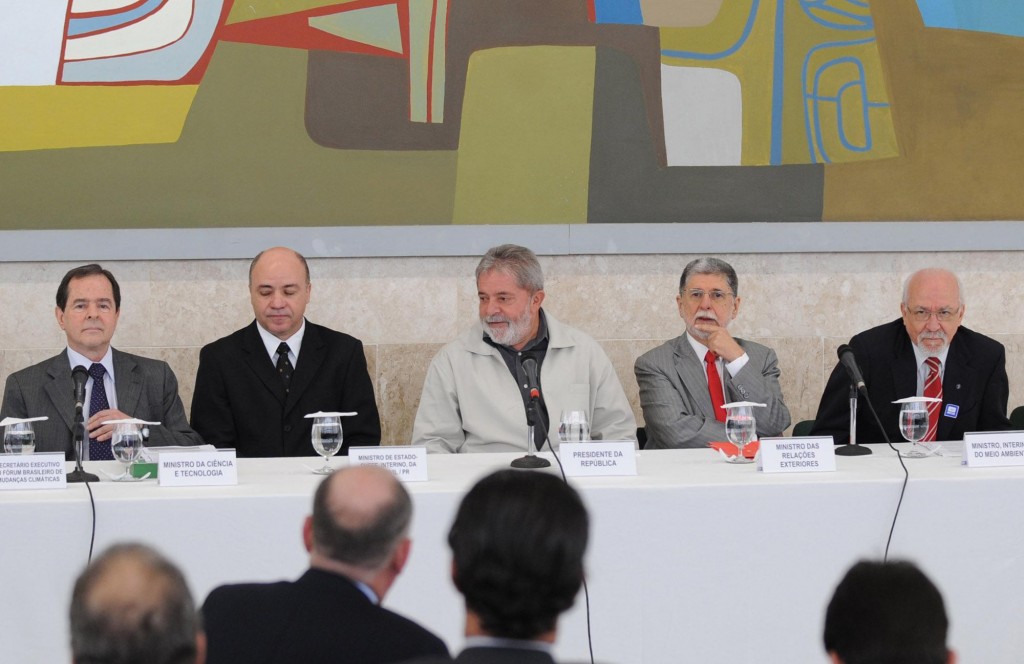And now it’s that time of year in Brazil…
Posted on 27. Oct, 2010 by Juliana Russar in Brazil
Para ler esse texto em português, clique aqui
… when the government makes announcements about their actions related to climate change with an eye on their participation in the Conference of Parties (CoP) of the UN Convention on Climate Change (UNFCCC), which usually happens every year since 1995, between November and December . This year it will occur between November 29 and December 10 in Cancun, Mexico.
Yesterday, there was a meeting of the Brazilian Forum on Climate Change (FBMC), in Brasilia, in the presence of President Lula, in order to present the second Brazilian inventory of greenhouse gases emission (GHGs), the sectorial plans on mitigation facing five sectors corresponding to the voluntary commitments the country made at CoP-15. Furthermore, they signed the decree regulating the National Fund on Climate Change and the 16th Conference of the Parties (COP-16) of the UNFCCC was also discussed.
The FBMC was created in 2000 by Decree no. 3515 aimed at raising awareness and mobilizing society to discuss and take positions on climate change issues. The Forum is composed by various ministries, representatives of non-governmental organizations, academia and the private sector, chairman of the House of Representatives, President of Senate, state governors, mayors of state capitals and it is chaired by the president, but generally, it is the executive secretary of the Forum that conducts the meetings. President Lula usually attends the meetings only once a year.
I was not present at the meeting, so this text is based on the (few) articles that came out about the event and also in tweets (long live Twitter!) from Fernanda Carvalho(TNC) and Gilberto Camara (INPE) who attended the meeting.
Unlike last year when, as CoP-15 approached, the media interest, as well as interest from various sectors of society, was focused on the government’s announcements, this year’s meeting of FBMC has gone unnoticed. This can be explained by the fact that climate change, despite having been incorporated in the government agenda in recent years, remains a marginal issue (in the middle of election season, one can hardly hear the candidates talk about it) and also because there are no great expectations for CoP-16. Even the Minister Celso Amorim confirmed during the meeting that he doesn’t see a great deal as a Cancun outcome, but expects progress in establishing a REDD (reducing emissions from deforestation and forest degradation) mechanism and the fund to finance mitigation and adaptation in developing countries. The foreign minister also said that a climate change agreement may be celebrated at Rio +20. Does this mean that Brazil is calling for the responsibility to reach an agreement to be placed on itself?
The Second National Communication, which includes the inventory of GHG emissions for the period 1990 to 2005, was presented (but not yet published on the MCT site). The first inventory was published in 2004 and comprised the period from 1990 to 1994. It is where the information that 75% of CO2 emissions in Brazil are from deforestation is. There was tremendous pressure to publish a new inventory with the latest information, as updated information is needed to define mitigation actions. Before Copenhagen, when the government announced a goal to reduce between 36 and 39% of their emissions by 2020, based on a business as usual scenario, many wondered where they had come up with these magic numbers because there was no recent published data to check how much each sector of the Brazilian economy is emitting and how much, in fact, each sector could reduce its emissions by. Therefore, how could the Brazilian government establish this goal if the latest data available was 1994? At the time, the Ministry of Science and Technology came out with a document with preliminary values (land use change and forestry -58%; agriculture - 22%, 16% energy and industrial processes 2%).
According to the second inventory, which will be officially presented at CoP-16, Brazil’s emissions of greenhouse gases increased by about 60% between 1990 and 2005, from 1.4 gigatonnes to 2.192 gigatonnes of carbon dioxide equivalent (CO2e - a measure that considers all greenhouse gases). The sector of land use change and forestry accounts for 61% of total emissions, agriculture 19%, energy 15%, industrial processes 3% and 2% waste treatment. Besides, it was also presented and estimated Brazilian GHG emissions in 2009: 1.775 gigatonnes of CO2 equivalent, 33% less than in 2005. The drop, according to Minister of Science and Technology, can be attributed to the reduction of deforestation in the Amazon in recent years. President Lula said in his speech that the goal announced during CoP-15 can be anticipated for 2016:
When we were in Copenhagen, we binded over 80% of our commitments to reducing emissions of greenhouse gases to two agendas: agriculture and deforestation, activities that are responsible for the vast majority of emissions in our country. We can say that these commitments are being met and exceeded the goals widely. Brazil, while living a time of great economic growth, has the lowest rate of deforestation over the last 21 years. Since the program to prevent and control deforestation in the Amazon [Action Plan for Prevention and control of Deforestation in the Amazon] was established in 2003 it avoided the emission of 2.9 billion tons of carbon dioxide. If we maintain this pace - and I’m sure it will happen - the goal announced at COP-15 will advance in four years, ie, we will have reduced deforestation by 80% in 2016 and not in 2020 as we were predicting.
The president also signed the decree regulating the National Fund on Climate Change (Climate Fund or FNMC) establishing the Steering Committee of the Fund, coordinated by the Ministry of Environment (MMA) and comprising representatives from government, academia, private sector, NGOs and labour unions, in order to manage, monitor and evaluate the application of resources in projects, studies and developments of mitigation and adaptation to climate change. Initially, the budget of FNMC for 2011 is $ 226 million, with $ 200 million repayable loan and financing aimed at the production area by BNDES and R$ 26 million administered by the MMA to invest in research projects, mobilization and ratings Impact of climate change. The Fund is considered pioneering as the resources used come from the special participation in the profits of oil production chain, but also may come from another source, including the fund to be established under the UNFCCC.
It was also presented the Executive Summary of the five action plans related to the sectors that have been prioritized with the adoption of National Policy on Climate Change that is committed to reduce future emissions of Brazil between 36 and 39% by 2020. The plans address prevention and control of deforestation in the Amazon and Cerrado - and the other three are related to energy, agriculture and steel. It is planned a meeting of FBMC in November, only to address the plans.
It is true, as I said, that the issue has gained importance in the government agenda, but there is still a long way to go for it become a priority and be incorporated into the development policy of the country. Over the past two years, the National Plan on Climate Change was launched (does anyone still remember it?), the Amazon Fund was created and the National Policy on Climate Change was approved. We can celebrate that now we have the tools, but except for the plan of prevention and combating deforestation in the Amazon that seems to be running, the implementation of other actions are lacking and bump into some government projects such as oil exploration in the pre-salt layer and PAC (that involves projects such as Belo Monte dams) - those of high priority to the Presidential Palace. By reducing emissions from deforestation in the Amazon, the next major effort will be to control deforestation in the Cerrado, biome that was until now ignored. Then comes the emissions of the agricultural sector. How can we reduce the rate of deforestation of the Cerrado and the emissions from this sector if the Forest Code is under threat? As Brazil seeks to be the host country of the Conference (Rio +20), in accordance with our minister, that will celebrate the climate deal/agreement, how can the country maintain these internal contradictions?










Great article Juliana!
Let’s hope that the new government to innaugurate commits at least at the same level as Lula did.
Hopefully the Climate Fund regulation has just been homologated by Lula and there will be room for more concrete actions, from various governmental levels and civil society, 2011 on.